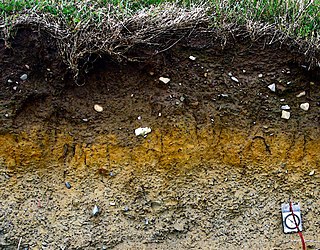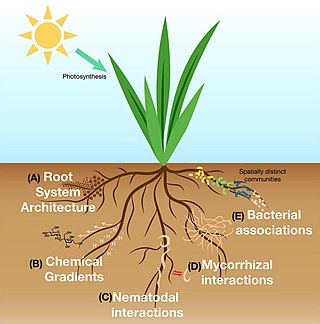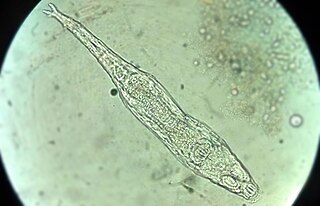Related Research Articles

In classical soil science, humus is the dark organic matter in soil that is formed by the decomposition of plant and animal matter. It is a kind of soil organic matter. It is rich in nutrients and retains moisture in the soil. Humus is the Latin word for "earth" or "ground".

Soil, also commonly referred to as earth or dirt, is a mixture of organic matter, minerals, gases, liquids, and organisms that together support life. Some scientific definitions distinguish dirt from soil by restricting the former term specifically to displaced soil.
Organic matter, organic material, or natural organic matter refers to the large source of carbon-based compounds found within natural and engineered, terrestrial, and aquatic environments. It is matter composed of organic compounds that have come from the feces and remains of organisms such as plants and animals. Organic molecules can also be made by chemical reactions that do not involve life. Basic structures are created from cellulose, tannin, cutin, and lignin, along with other various proteins, lipids, and carbohydrates. Organic matter is very important in the movement of nutrients in the environment and plays a role in water retention on the surface of the planet.

The rhizosphere is the narrow region of soil or substrate that is directly influenced by root secretions and associated soil microorganisms known as the root microbiome. Soil pores in the rhizosphere can contain many bacteria and other microorganisms that feed on sloughed-off plant cells, termed rhizodeposition, and the proteins and sugars released by roots, termed root exudates. This symbiosis leads to more complex interactions, influencing plant growth and competition for resources. Much of the nutrient cycling and disease suppression by antibiotics required by plants, occurs immediately adjacent to roots due to root exudates and metabolic products of symbiotic and pathogenic communities of microorganisms. The rhizosphere also provides space to produce allelochemicals to control neighbours and relatives.

Soil biology is the study of microbial and faunal activity and ecology in soil. Soil life, soil biota, soil fauna, or edaphon is a collective term that encompasses all organisms that spend a significant portion of their life cycle within a soil profile, or at the soil-litter interface. These organisms include earthworms, nematodes, protozoa, fungi, bacteria, different arthropods, as well as some reptiles, and species of burrowing mammals like gophers, moles and prairie dogs. Soil biology plays a vital role in determining many soil characteristics. The decomposition of organic matter by soil organisms has an immense influence on soil fertility, plant growth, soil structure, and carbon storage. As a relatively new science, much remains unknown about soil biology and its effect on soil ecosystems.
Bulk soil is soil outside the rhizosphere that is not penetrated by plant roots. The bulk soil is like an ecosystem, it is made up of many things such as: nutrients, ions, soil particles, and root exudates. There are many different interactions that occur between all the members of the bulk soil. Natural organic compounds are much lower in bulk soil than in the rhizosphere. Furthermore, bulk soil inhabitants are generally smaller than identical species in the rhizosphere. The main two aspects of bulk soil are its chemistry and microbial community composition.

Immobilization in soil science is the conversion of inorganic compounds to organic compounds by micro-organisms or plants by which the compounds become inaccessible to plants. Immobilization is the opposite of mineralization. In immobilization, inorganic nutrients are taken up by soil microbes and become unavailable for plant uptake. Immobilization is therefore a biological process controlled by bacteria that consume inorganic nitrogen and form amino acids and biological macromolecules. Immobilization and mineralization are continuous processes that occur concurrently whereby nitrogen of the decomposing system is steadily transformed from an inorganic to an organic state by immobilization and from an organic to an inorganic state by decay and mineralization.

Soil respiration refers to the production of carbon dioxide when soil organisms respire. This includes respiration of plant roots, the rhizosphere, microbes and fauna.
Soil organic matter (SOM) is the organic matter component of soil, consisting of plant and animal detritus at various stages of decomposition, cells and tissues of soil microbes, and substances that soil microbes synthesize. SOM provides numerous benefits to the physical and chemical properties of soil and its capacity to provide regulatory ecosystem services. SOM is especially critical for soil functions and quality.
Soil biodiversity refers to the relationship of soil to biodiversity and to aspects of the soil that can be managed in relative to biodiversity. Soil biodiversity relates to some catchment management considerations.
Greenhouse gas emissions from wetlands of concern consist primarily of methane and nitrous oxide emissions. Wetlands are the largest natural source of atmospheric methane in the world, and therefore remain a major area of concern with respect to climate change. They contribute approximately 167 Tg of methane to the atmosphere per year. Wetlands account for approximately 20 percent of atmospheric methane through emissions from soils and plants. Wetlands are characterized by water-logged soils and distinctive communities of plant and animal species that have evolved and adapted to the constant presence of water. This high level of water saturation creates conditions conducive to methane production.

Soil mesofauna are invertebrates between 0.1mm and 2mm in size, which live in the soil or in a leaf litter layer on the soil surface. Members of this group include nematodes, mites, springtails (collembola), proturans, pauropods, rotifers, earthworms, tardigrades, small spiders, pseudoscorpions, opiliones (harvestmen), enchytraeidae such as potworms, insect larvae, small isopods and myriapods. They play an important part in the carbon cycle and are likely to be adversely affected by climate change.

Soil carbon storage is an important function of terrestrial ecosystems. Soil contains more carbon than plants and the atmosphere combined. Understanding what maintains the soil carbon pool is important to understand the current distribution of carbon on Earth, and how it will respond to environmental change. While much research has been done on how plants, free-living microbial decomposers, and soil minerals affect this pool of carbon, it is recently coming to light that mycorrhizal fungi—symbiotic fungi that associate with roots of almost all living plants—may play an important role in maintaining this pool as well. Measurements of plant carbon allocation to mycorrhizal fungi have been estimated to be 5 to 20% of total plant carbon uptake, and in some ecosystems the biomass of mycorrhizal fungi can be comparable to the biomass of fine roots. Recent research has shown that mycorrhizal fungi hold 50 to 70 percent of the total carbon stored in leaf litter and soil on forested islands in Sweden. Turnover of mycorrhizal biomass into the soil carbon pool is thought to be rapid and has been shown in some ecosystems to be the dominant pathway by which living carbon enters the soil carbon pool.

Extracellular enzymes or exoenzymes are synthesized inside the cell and then secreted outside the cell, where their function is to break down complex macromolecules into smaller units to be taken up by the cell for growth and assimilation. These enzymes degrade complex organic matter such as cellulose and hemicellulose into simple sugars that enzyme-producing organisms use as a source of carbon, energy, and nutrients. Grouped as hydrolases, lyases, oxidoreductases and transferases, these extracellular enzymes control soil enzyme activity through efficient degradation of biopolymers.

Ectomycorrhizal extramatrical mycelium is the collection of filamentous fungal hyphae emanating from ectomycorrhizas. It may be composed of fine, hydrophilic hypha which branches frequently to explore and exploit the soil matrix or may aggregate to form rhizomorphs; highly differentiated, hydrophobic, enduring, transport structures.

The root microbiome is the dynamic community of microorganisms associated with plant roots. Because they are rich in a variety of carbon compounds, plant roots provide unique environments for a diverse assemblage of soil microorganisms, including bacteria, fungi and archaea. The microbial communities inside the root and in the rhizosphere are distinct from each other, and from the microbial communities of bulk soil, although there is some overlap in species composition.
Seventeen elements or nutrients are essential for plant growth and reproduction. They are carbon (C), hydrogen (H), oxygen (O), nitrogen (N), phosphorus (P), potassium (K), sulfur (S), calcium (Ca), magnesium (Mg), iron (Fe), boron (B), manganese (Mn), copper (Cu), zinc (Zn), molybdenum (Mo), nickel (Ni) and chlorine (Cl). Nutrients required for plants to complete their life cycle are considered essential nutrients. Nutrients that enhance the growth of plants but are not necessary to complete the plant's life cycle are considered non-essential. With the exception of carbon, hydrogen and oxygen, which are supplied by carbon dioxide and water, and nitrogen, provided through nitrogen fixation, the nutrients derive originally from the mineral component of the soil. The Law of the Minimum expresses that when the available form of a nutrient is not in enough proportion in the soil solution, then other nutrients cannot be taken up at an optimum rate by a plant. A particular nutrient ratio of the soil solution is thus mandatory for optimizing plant growth, a value which might differ from nutrient ratios calculated from plant composition.
Saprotrophic bacteria are bacteria that are typically soil-dwelling and utilize saprotrophic nutrition as their primary energy source. They are often associated with soil fungi that also use saprotrophic nutrition and both are classified as saprotrophs.

Octolasion lacteum is a species of earthworm of the genus Octolasion. In New Zealand it has been found in West Coast soils and in Canterbury. They are found in mostly moist areas deep under the soil as they feed in the nutrients within the soil. Unlike other worm species, these are known to survive in acidic soil as well as soil that is not as organic compared to other places. They provide some important roles in the ecosystem as well as threats to other species as well. After a drought, they help the soil get more organic by adding more carbon dioxide in the soil and the waste from the O. lacteum also provides nutrients for the soil. In another case, they can also be invasive in a way that they suck up carbon in the soil which means plants have less causing a disruption to the food web. Lastly, they reproduce by cross parthogenic reproduction.
The term humus form is not the same as the term humus. Forest humus form describes the various arrangement of organic and mineral horizons at the top of soil profiles. It can be composed entirely of organic horizons, meaning an absence of the mineral horizon. Experts worldwide have developed different types of classifications over time, and humus forms are mainly categorized into mull, mor, and moder orders in the ecosystems of British Columbia. Mull humus form is distinguishable from the other two forms in formation, nutrient cycling, productivity, etc.
References
- ↑ Bird, Jeffrey A.; Herman, Donald J.; Firestone, Mary K. (April 2011). "Rhizosphere priming of soil organic matter by bacterial groups in a grassland soil". Soil Biology and Biochemistry . Elsevier BV. 43 (4): 718–725. doi:10.1016/j.soilbio.2010.08.010. ISSN 0038-0717.
Plants often impact the rate of native soil organic matter turnover through root interactions with soil organisms
- ↑ Jackson, Oyindamola; Quilliam, Richard S.; Stott, Andy; Grant, Helen; Subke, Jens-Arne (July 2019). "Rhizosphere carbon supply accelerates soil organic matter decomposition in the presence of fresh organic substrates" . Plant and Soil. 440 (1–2): 473–490. doi:10.1016/S0038-0717(03)00123-8.
(positive priming is the) acceleration of SOM decomposition caused by change in microbial community structure and extracellular enzyme production (Blagodatskaya and Kuzyakov 2008).
- ↑ Huo, Changfu; Luo, Yiqi; Cheng, Weixin (April 2017). "Rhizosphere priming effect: A meta-analysis". Soil Biology and Biochemistry . Elsevier BV. 111: 78–84. doi: 10.1016/j.soilbio.2017.04.003 . ISSN 0038-0717.
Rhizosphere priming is crucial for regulating soil carbon and nitrogen biogeochemical cycles. ... The presence of live roots can suppress soil organic matter (SOM) decomposition rates by 50% or stimulate it by 380%, when compared with soil incubations without plants (Cheng et al., 2014). ... The RPE is a change of SOM decomposition rate due to the presence of living roots and aboveground vegetation (Kuzyakov, 2002), while the general priming effect (PE) is a change of SOM decomposition rate due to substrate additions Löhnis, 1926; Bingemann et al., 1953).